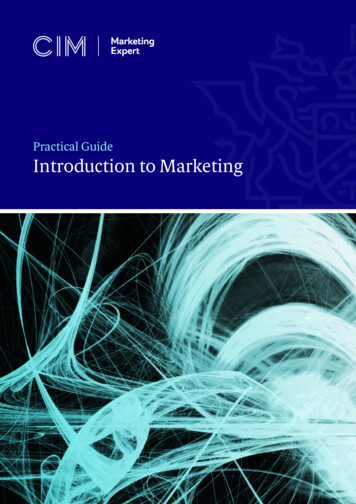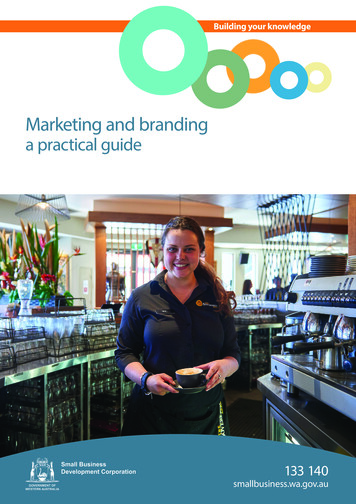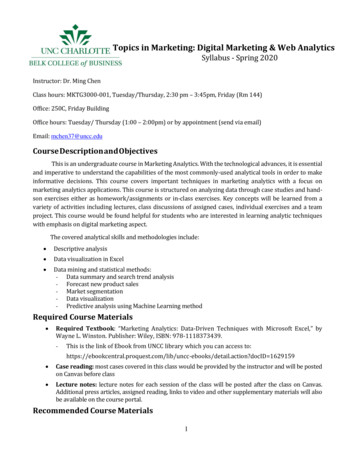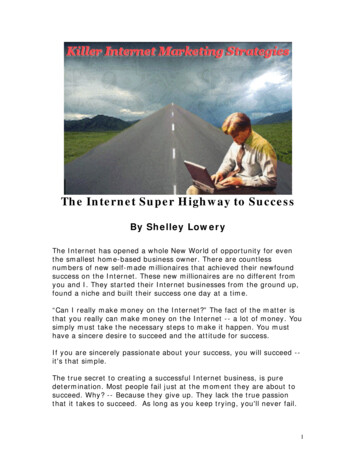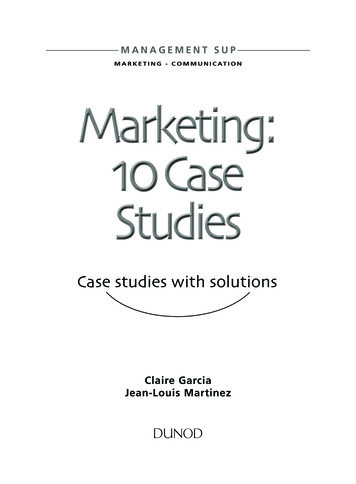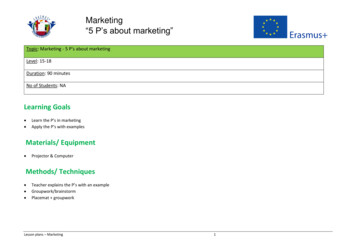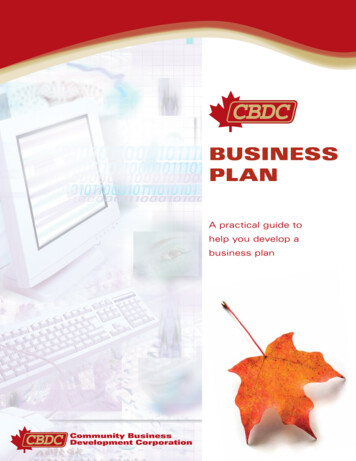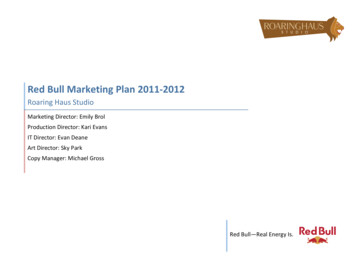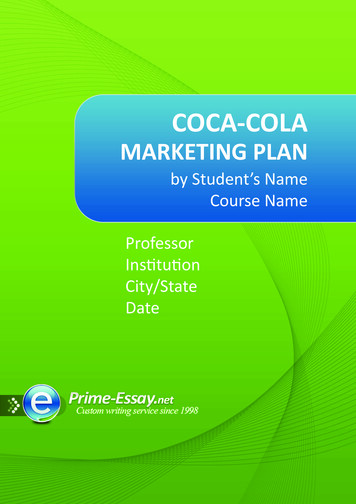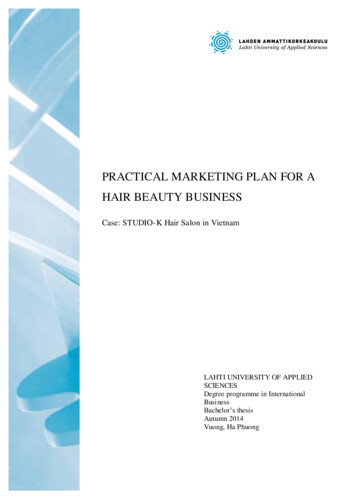
Transcription
PRACTICAL MARKETING PLAN FOR AHAIR BEAUTY BUSINESSCase: STUDIO-K Hair Salon in VietnamLAHTI UNIVERSITY OF APPLIEDSCIENCESDegree programme in InternationalBusinessBachelor’s thesisAutumn 2014Vuong, Ha Phuong
Lahti University of Applied SciencesDegree Programme in International BusinessVUONG, HA PHUONGPractical marketing plan for a hair beautybusinessCase: Studio-K hair salon in VietnamBachelor’s Thesis in International Business81 pages, 2 pages of appendicesAutumn 2014ABSTRACTBeauty has been seen as a significant element in life among other ultimate valueslike goodness, truth, and justice. Hence it is a universal desire of people to takegood care of their beauty and appearance in any occasion. Consequently, it createshuge opportunities for entrepreneurs within the beauty industry all over the world.In Ho Chi Minh City, Vietnam, the beauty-care service industry is one of the mostflourishing industries with the growing number of beauty-conscious women.There is a wide range of beauty care services like skin care, color cosmetics,fragrances. Hair care is also one of them.This thesis aims at analyzing the hairdressing market in Ho Chi Minh and themarketing process to make a practical marketing plan for the case company. Sincethe case company is in its first year of business as a startup company; acomprehensive marketing plan is necessary to ensure profitability and success.In this study, the author applies deductive approach with qualitative researchmethod. Data is collected from a variety of sources such as published texts in thetheoretical part; the Internet, interviews, the author’s own observations and otherunpublished sources in the empirical section.The research structure is divided into two parts: the theoretical framework and theempirical findings. In brief, the theoretical framework contains theories aboutmarket analysis, customer segmentation, marketing plan and marketing mix. Inthe empirical section, the author begins with the overview of the targeted hairbeauty market followed with the case company analysis. Correspondingly, amarketing plan is generated to help the company to attain its overall strategicobjectives. Moreover, the author puts a major concentration on the marketing mix,the set of tactical marketing tools to establish a strong positioning of the casecompany in the market. The plan is based on the theory that has been presented inthe theoretical framework.The hair dressing business is seen as a start up idea for the entrepreneur in termsof financial risks because even in economic downturns, people still have to gettheir hair done. With this concentrated marketing plan, the case company isexpected to enhance its visibility and gain profit in the first year of a start-upbusiness.
Key words: marketing process, marketing mix, hair salon industry, Ho Chi MinhCity, Vietnam
CONTENTS123INTRODUCTION11.1Background11.2Thesis Objectives and Research Questions21.3Research Methodology and Data Collection31.4Thesis Structure7THE MARKETING PROCESS92.1Understanding the marketplace and organizational insights92.1.1External analysis102.1.2Internal analysis172.2Designing a customer-driven marketing strategy182.2.1Customer segmentation182.2.2Market positioning192.3The marketing plan212.4Marketing omotion272.5Marketing implementation282.6Marketing control30EMPIRICAL FINDINGS323.1Overview of the market323.1.1Salon and spa industry in general323.1.2Hair beauty industry in Ho Chi Minh City, Vietnam353.1.3Porter’s Five Forces analysis in hair-beauty industry of HoChi Minh City373.2Case company403.2.1Overview413.2.2Staff423.2.3SWOT Analysis of the Case Company423.3Developing Marketing Strategy433.3.1Customer segmentation443.3.2Positioning46
453.3.3Contents of a Marketing Plan483.4Constructing a marketing mix503.4.1Products and 3.5Implementation593.6Marketing control61CONCLUSIONS624.1Findings624.2Limitations and further suggestions634.3Reliability and Validity65SUMMARYREFERENCESAPPENDICES6667
LIST OF FIGURESFigure 1: Research Process . 3Figure 2: Deductive approach (Trochim 2006) . 4Figure 3: Data collection methods (Kumar 2005, 118) . 6Figure 4: Thesis structure . 7Figure 5: Theorectical Framework . 8Figure 6: Marketing process (Kotler & Amstrong 2012) . 9Figure 7: Porter's Five Forces Model (Hanlon 2013) . 11Figure 8: High and low industry profit characteristics (Ovidijus 2013). 12Figure 9: SWOT model (Koppel 2014) . 17Figure 10: Repositioning in a segmented market. Adapted from (Doyle, 2002). 21Figure 11: 4Ps to 4Cs (Kotler, et al. 2012, 76) . 23Figure 12: The four Ps of marketing mix (Kotler, et al. 2012) . 24Figure 13: Comparison of conventional distribution channel with verticalmarketing system (Kotler & Amstrong 2012) . 27Figure 14: Return on Marketing Investment (Kotler 2012, 82). 30Figure 15: Marketing control (Kotler & Amstrong 2012, 77) . 31Figure 16: Employment-based salons and spas in comparison with private sectors(Professional Beauty Association 2013) . 33Figure 17: Salon industry establishment and sales over the last decade(Professional Beauty Association 2013) . 34Figure 18: Porter's Five Forces of Hair- beauty industry in Ho Chi Minh City . 38Figure 19: On-street hairdresser . 39Figure 20: Possible value propositions (Kotler, et al. 2012, 238) . 46Figure 21 : Value-based pricing (Kotler, et al. 2012, 316) . 51Figure 22 : Cost-based pricing (Kotler & Amstrong 2012, 316) . 52Figure 23: Studio K's location . 54Figure 24: Hair salon design samples (Archpart 2013) . 55Figure 25: Hair salon floor plan sample (Archpart 2013) . 56Figure 26: Facebook page of a hair salon (Peagler 2014) . 57Figure 27: Instagram account of a hair salon (Peagler 2014) . 58Figure 28: Blogspot sample of a beauty blogger (Beautifyinglife 2014) . 58Figure 29: Client loyalty card sample . 59
LIST OF TABLESTable 1: Distinctions between quantitative and qualitative research (Padgett 1998,3) . 5Table 2: Example of barriers . 13Table 3: Bargaining power of customers (Anthony 2011) . 14Table 4: Analysis the threat of substitute (Pratt 2014) . 16Table 5: Customer segmentation . 45Table 6: Marketing plan for Studio-K . 48Table 7: Sample of Studio K's Price List . 52Table 8: Gantt chart for marketing implementation . 60Table 9: Findings of the study . 62Table 10: Contingency plan for Studio K . 64
GLOSSARYDIYDo It YourselfEUREuroGDPGross Domestic ProductMROIMarketing Return On InvestmentROIReturn On InvestmentVNDVietnam Dong
1INTRODUCTIONThis chapter aims to present the main idea of the study and the trigger for thechosen topic. Firstly, section 1.1 is the background information of the study.Secondly, research objectives and questions are conducted in section 1.2 while anoverview of the research methodology is explained in section 1.3. Lastly insection 1.4, thesis structure and theoretical framework are described with a clearillustration.1.1BackgroundBefore leaving the house each day, people have a tendency to undergo a personalized beautification ritual. Included in that ritual are the daily shower and shave,the weekly nail trim, and the monthly haircut. (Sena 2014)According to Lopaciuk & Loboda (2013), the beauty industry has been expandingdramatically over decades. Therefore, it offers a diverse range of opportunities forthe interested entrepreneurs. As a women, just like the other women in the world,the author always keeps in mind the importance of taking care of herself and agood appearance. As a business student, she is among entrepreneurs-to-be whohas much interest about the beauty industry. Especially during her third yearstudying in university, she took part in an exchange program in South Korea, acountry where beauty industry is acknowledged as a hub for cosmetic innovationin Asia and is fast becoming a role model for the global cosmetics industry (Incosmetics Asia 2013).During six months in South Korea, the author had a chance to observe and studymany innovative cases of start-up companies competing and striving in theKorean beauty industry. It became a remarkable trigger to boost the author takingaction for her ambition as an entrepreneur. Therefore, she decided to cooperatewith her friend to open a start-up hair salon in Ho Chi Minh City, Vietnam in2015. Although the business plan has been done already, a concentrated marketingstrategy is necessary to assist the business in a competitive market. Hence, as aco-founder, the author attempts to conduct a marketing plan for her small start-up.
2By definition, a marketing plan is a business document created with the purposeof describing the current market position of a firm and its strategy for the periodcovered by the marketing plan, from one to five years (Duermyer 2014). Thisstudy acts a short-term plan for the case company and will be updatedperiodically.This thesis study plays a key role for the establishment of her new start-up, whichprovides the analysis and requisites needed from the firm to enter a competitivemarket. It is the first stone of the foundation for a dream, which may be sparklingin the future but surely requires hard-working at first.1.2Thesis Objectives and Research QuestionsThis study aims at searching for the best marketing strategies for a small businessgetting into a competitive market. The research will focus on analyzing the targetmarket, the case company and effective marketing activities to acknowledge thecase company in the targeted market. In consequence, the following researchquestion is formed:What is an effective marketing strategy for a new beauty hair salon in acompetitive market of Ho Chi Minh City, Vietnam?To provide a sufficient answer to the above question, these sub-questions areraised: What are the objectives of the case company when entering thetargeted market ? How competitive is the target market? How the company differentiates and positions itself in the competitivemarket? What is the suitable marketing strategy for the case company? What are the promotional tools needed for the marketing strategy?
31.3Research Methodology and Data CollectionIn this session, the process of research methodology adopted in the thesis isintroduced.First of all, the information needs for analyzing this topic have been defined bythe author are: the company information like background, current situation, andproblem occurs and cost analyses; and market information.Secondly, all the information acquired can be tracked from the three main sources: Theoretical framework:o Primary data: interviewso Secondary data: books, journals, internet, articles, etc.o Tertiary data: abstracts, dictionary, etc. Empirical framework:o Primary data: interviews, questionnaires sent via emails, etc.oSecondary data: internet, newspapers, books, company reports,etc.Thirdly, the research process of this study is shown in the figure 1 below:Formulating theresearch topicFindings andSummaryFigure 1: Research ProcessDefining researchquestionsData AnalysisChoosing theresearch approachDEDUCTIVEChoice of researchmethodQUALITATIVE
4In any research project, research methodology is the crucial part of all theses. Itexplains how writers come up with the thesis topic and step by step build up theresearch. Mark Saunders Philip Lewis and Adrian Thornhill (2009, 144)recommended that there are two approaches that based on the reasoning that wechose: deductive and inductive. In deductive approach, theory often starts first,and then a research strategy is designed to test that theory. In a contrary, ifcollected data and statistics are used for generating a new or adapting an existingtheory, inductive is used. In this thesis, because the author will start with logicalthinking about the hair beauty market in order to analyze the present trend andfind a good marketing plan for the case company. Therefore, deductive is appliedas a research approach, which is indicated in Figure 2.ConfirmationObservationHypothesisTheoryFigure 2: Deductive approach (Trochim 2006)Beside research approach, methodological choice is very important as well. Thereare two main methods which are quantitative and qualitative research.Quantitative research is to find a reliable statistical result by collecting numericaldata through surveys like online, phone, paper and audits (Amora 2010); whilequalitative data refers to non-numeric data, which can be obtained throughinterviews and written reports. People are doing research to understand what, howand why things happen. If people only need to know what happened, quantitativesatisfies this purpose. However, qualitative research goes further than that; it is
5used to explore deeper inside people’s awareness, understanding and motivation.According to Saunders (2009), in qualitative research, the aim is not to measurestatistically but to understand and interpret the reasons and meanings of thephenomenon. Since this study is primarily processed based on unstructuredinterview and desk research to answer the research questions, qualitative researchmethod is employed.Table 1: Distinctions between quantitative and qualitative research (Padgett c, in vivoUncontrolled conditionsOpen systemsHolistic, thick descriptionDynamic realityResearchers as instrument of DatacollectionCategories result from data analysisDeductiveScientific method, decontextualizingControlled conditionsClosed systemsParticularisticStable realityStandardized data collection instrumentCategories precede data analysisIn order to develop a fuller understanding of the research, multiple literaturesources are essentially applied (Saunders et al. 2009, 68). There are two maincategories of information sources named primary and secondary which are shownin Figure 3 below.
6Figure 3: Data collection methods (Kumar 2005, 118)In the theoretical part, secondary literature sources are mainly used. These sourcesconsist of published books, articles, journals and previous studies by otherresearchers.On the contrary, primary sources are mainly used to conduct the empirical part.The analysis of the targeted market and the case company is attempted thanks tothe confidential information gathered from the interviews with the case companyowner and Mr. Hoang Long Le, currently working as a hairstylist professor atJBart Hair Academy. Due to the time constraint and the geographical distance, allthe interviews were done via emails and messenger chatting devices. Structure ofthe interview including lists of questions can be found in the appendices.Moreover, the author’s observation while studying in Korea is applied during theprocess of creating the marketing strategies and implementation plan.
71.4Thesis StructureThe following figure illustrates the structure of this thesis:BackgroundThesisstructureThesis objectivesResearch questionsResearchmethodologyTHE MARKETING PROCESSEMPERICAL FINDINGSMarket & yMixand EvaluationOverviewCONCLUSIONSSUMMARYFigure 4: Thesis structure
8The thesis has five chapters in total which is showed in figure 4. It is structured intwo main parts which are theoretical and empirical.The theoretical part of this thesis is based mainly on literature relating tomarketing process. Some related issues like company’s internal and externalanalysis, marketing strategy and marketing mix. After that marketingimplementation and control will be explained more in the section. In figure 5, theauthor is giving a more detailed theoretical framework.Internal analysisImplementationMarketingMarketing MixStrategyExternal analysisMarketing control(Action plans)- CustomerSegmentationFor the marketingcampaign- Positioning- Marketing P lanFigure 5: Theorectical FrameworkThe second section is empirical part, which is based on desk-research informationand semi-structure interviews and surveys of some key people. These people arethose will be participating in marketing and management process of the casecompany. Chapter three acts as external and internal analysis for target market andthe case company respectively.
92THE MARKETING PROCESSMarketing is defined as a process where companies create value for customer andbuild strong customer relationships in order to get value from customer in return.In this chapter, the marketing process will be demonstrated in five steps:understanding the marketplace and organizational insights, designing marketingstrategies and constructing marketing programs.Market analysisImplementation gramsMarketingcontrolFigure 6: Marketing process (Kotler & Amstrong 2012)2.1Understanding the marketplace and organizational insightsIt is important to understand customer needs, wants and demands in order to buildwant-satisfying market offerings and building value-laden customer relationships.This increases long-term customer equity for the firm. (Jethani 2013)Analysis of internal factors and external conditions is important to drawing out aspecific strategy. The analysis has to be carrying out at both an internal level andat an external level in order to discover all opportunities and threats of theexternal environment as well as the strengths and weaknesses of the companies.To make it short, in order to understand the market place and organizationinsights, it is necessary to conduct an internal and external analysis of thecompany and the industry.
102.1.1External analysisAn external analysis can be defined as “the process of scanning and evaluating anorganization’s various external environmental sectors to determine positive andnegative trends that could impact organizational performance”. (Coulter 2005, 66)There are a number of factors have an influence on a company’s strategicdecisions. The external environment is among those things and should befrequently observed. It is helpful for analyzing by answering the followingquestions: What should be awarded of when examining environment factors? Arethey th
action for her ambition as an entrepreneur. Therefore, she decided to cooperate with her friend to open a start-up hair salon in Ho Chi Minh City, Vietnam in 2015. Although the business plan has been done alr


